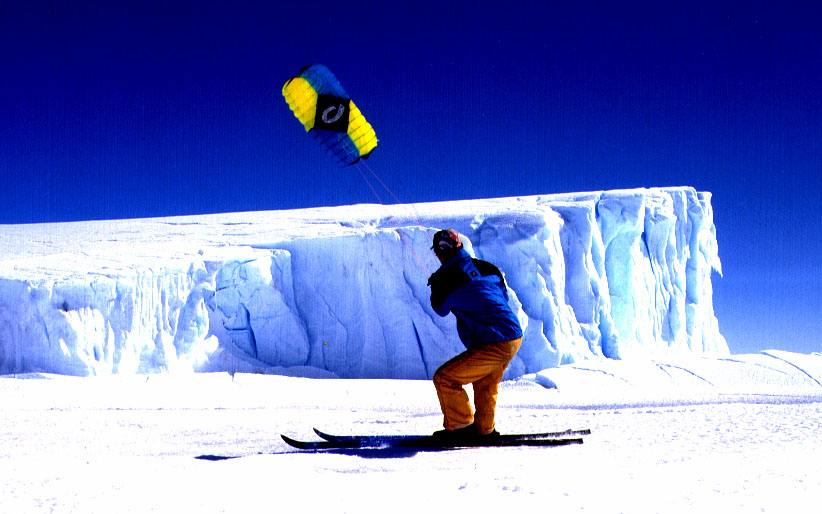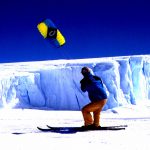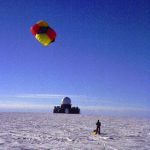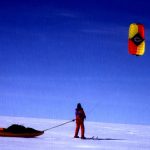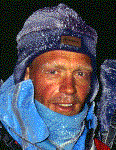 The evening breeze was strengthening as I collapsed my telescopic ski poles and threw them into the back of the Hagglunds. Glancing sideways, I eyed Justin carving some graceful snow board turns into the wind-packed snow of Fischer Nunatak. Damn those boards. I was a telemark skier up until two hours ago; now I’ll have to buy a new toy.
The evening breeze was strengthening as I collapsed my telescopic ski poles and threw them into the back of the Hagglunds. Glancing sideways, I eyed Justin carving some graceful snow board turns into the wind-packed snow of Fischer Nunatak. Damn those boards. I was a telemark skier up until two hours ago; now I’ll have to buy a new toy.
Bidding adios to the small group of intrepids, I turned towards Mawson Station – 20km distant – pulled on the handles of my Quadrifoil, and the kite came to life, launching into the air like a rocket. Momentarily airborne, I brought my skis parallel, then landed firmly on the snow, edges rolled, body leaning like a Patagonian tree. “More than just a breeze,” I told myself. Rows of sastrugi – wind-formed ridges of hard snow – ran across my course, availing me of a mogul course, slalom track and jumping ground all in one. Fond memories flooded my mind as I set the kite, brightly illuminated by the crimson rays of the setting sun.
A sudden cold blast from the south and I was traveling fast; too fast for the terrain, too fast for my skis, just plain too fast. As if the word Providence had been scrubbed from the history of language, snow turned to blue ice and Beelzebub hit the turbo switch. A string of telltale cracks passed under my smoking skis as I pulled on the brake lines to drop the kite. Useless. I overtook the luffing mass, edges glissading hopelessly over the frictionless ice. I flew over the bridge of the first crevasse, skittered across the second and pulled up short of the monster crack, heart leaping from my chest. Welcome to kiting in Antarctica.
In 1996/97 I spent 6 months on the icy continent, working for the Australian Antarctic Division as a Field Training Officer. My weekdays were spent training expeditioners how to survive in Antarctica. Everything from mountaineering to crevasse rescue, safety on sea-ice to radar navigation, search and rescue to vehicle extraction. Weekends, however, were spent playing – ice climbing, sailing ice yachts, skiing, rock climbing on cold and brittle granite and searching for new ground to skite on (ski and kite).
The Mawson coastline is peppered with rocky islands. These make natural dragnets which trap the blizzard-driven snow that sweeps in from the frozen interior. On one outing I found a beautifully formed half pipe nestled in a small secluded valley. The wind, as always, was blowing in from the south and straight through this snowy channel. Heaven.
A snow drift had built up on the windward side of the island, forming a natural ramp from the sea into the gully, a similar drift existed on the far side. Like a golfer studying for the perfect putt, I paced up and down, calculating the entry, scanning the natural lips and re-entry points, and contemplated the exit. Time to shoot.
Cruising up the drift, I timed a loop of the kite to skim a large boulder and pull me through a narrow gap into the gully. Bad timing here could lead to a fall into a small but severe meltlake. No thanks. Once into the gully, I could pull up onto the flanks on either side by edging my skis and powering on with the kite.
At full height, a jump turn brought me facing downhill, kite repositioned for a speedy dash to the other side. With half a dozen turns behind me the exit loomed all too quickly – a pull up an embankment followed by a jump off a 2 meter cornice onto the leeward drift. A perfect run, and only my first. It remained the best.
I returned the following week with a friend, eager to show off my new sport, but wind and sun had taken their toll. The drifts had shifted, the flanks had melted, the cornice slumped. This served to make the discovery even sweeter. I had snatched a piece of time from Antarctica and converted it into an indelible kaleidoscope of images, true enough but never again repeated.

